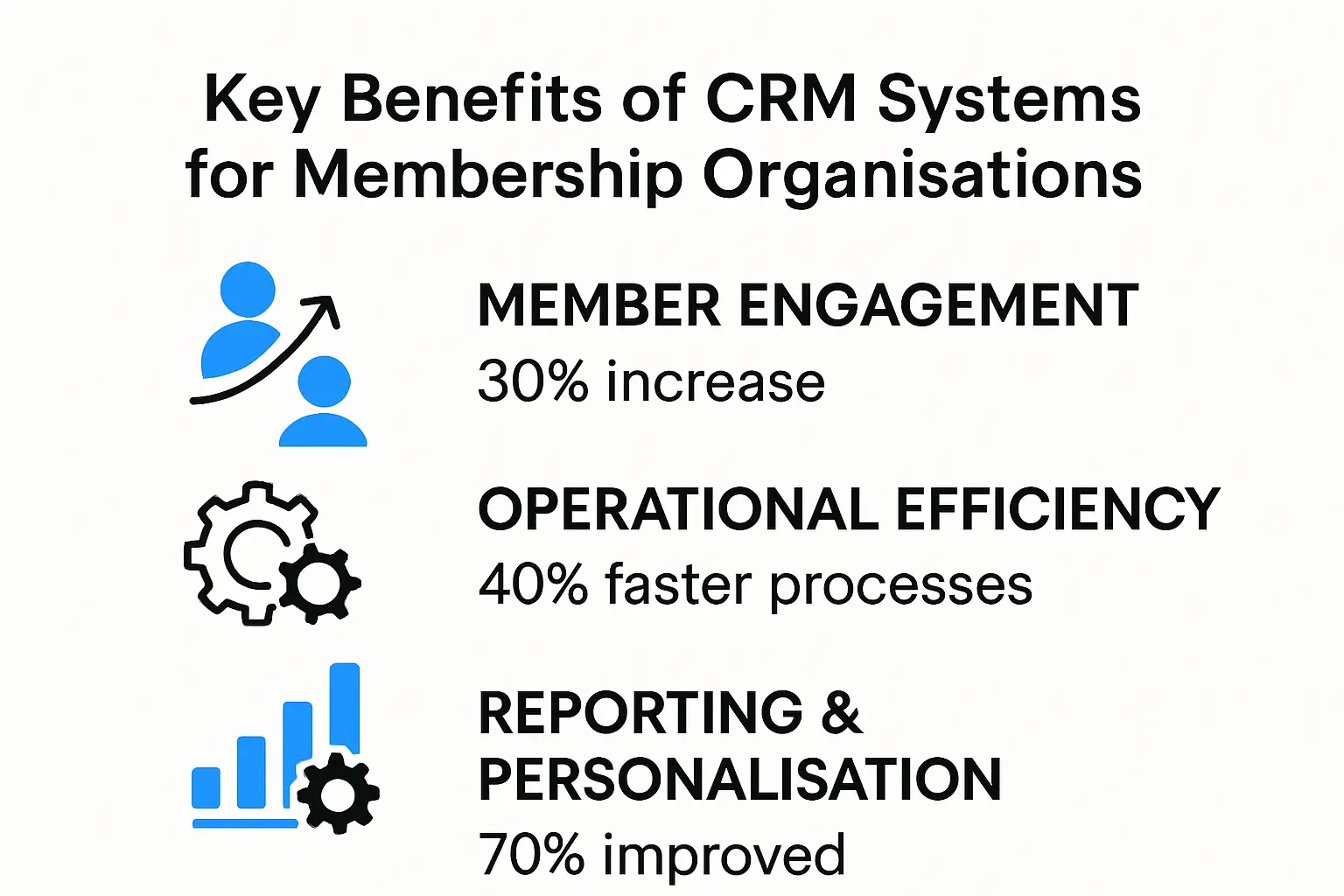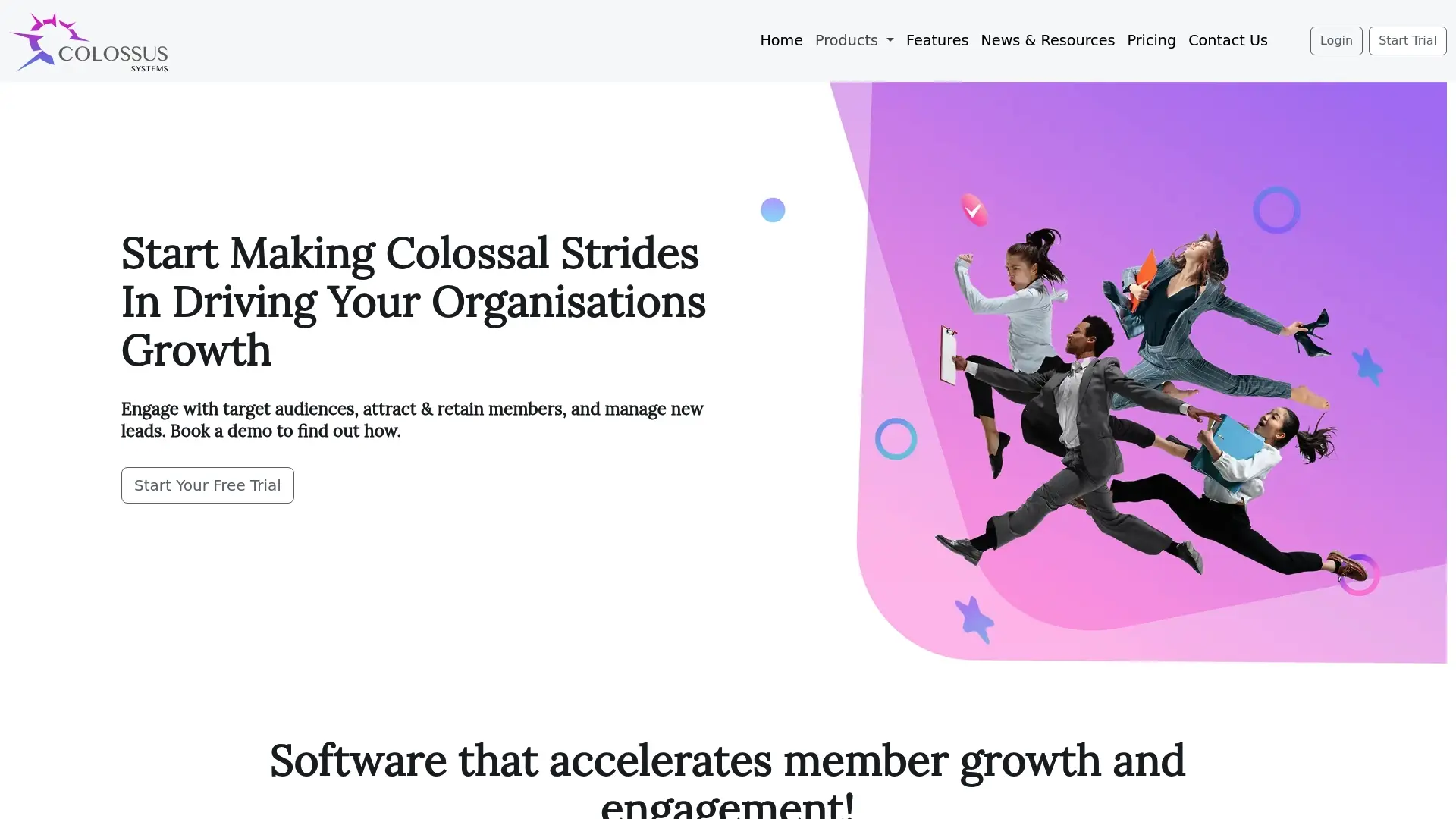What Is a CRM System? Guide for Membership Groups 2025

Membership organisations handle a dizzying amount of member data, communication, and event planning every day. You might think emails and spreadsheets keep everything afloat. Yet over 70% of membership groups now rely on dedicated CRM systems to personalise member experiences and automate routine tasks. The surprise is not in the software itself but in how much it transforms what your team can actually achieve with the data you already have.
Table of Contents
- Understanding What Is A CRM System
- Key Benefits Of CRM For Membership Organisations
- Choosing The Right CRM System For Your Needs
- Best Practices For Implementing A CRM System
Quick Summary
| Takeaway | Explanation |
|---|---|
| CRM systems enhance member interactions. | They help organisations consolidate data for personalising communication and improving member satisfaction. |
| Streamline operations with automated processes. | CRM systems reduce manual tasks, allowing staff to focus on high-value initiatives and improving efficiency. |
| Select the right CRM through needs assessment. | Evaluating organisational requirements ensures the chosen CRM fits seamlessly with existing workflows and strategic goals. |
| Effective implementation requires strategic planning. | Organisations must develop clear objectives and training programs to ensure successful adoption of the CRM system. |
| Leverage data for informed decision-making. | Advanced reporting tools in CRM systems provide insights that guide strategies for member engagement and retention. |
Understanding What Is a CRM System
A Customer Relationship Management (CRM) system represents a sophisticated technological solution designed to help organisations manage interactions and relationships with members, stakeholders, and potential contacts. At its core, a CRM system functions as a centralised database that captures, tracks, and analyses critical information about individuals connected to an organisation.
The Fundamental Purpose of CRM Systems
Research from Educause indicates that CRM tools are increasingly vital for organisations seeking to streamline engagement and make data-driven decisions. These systems go beyond simple contact management, offering comprehensive capabilities that transform how organisations interact with their members.
A robust CRM system enables membership groups to consolidate member information, track communication history, manage interactions, and generate insights that support strategic planning. By creating a holistic view of member relationships, organisations can personalise interactions, improve communication strategies, and ultimately enhance member satisfaction and retention.
Technical Infrastructure and Integration Capabilities
Cloud computing research highlights that modern CRM systems leverage advanced technological infrastructures, allowing seamless integration with other business applications. This means organisations can connect their CRM with enterprise resource planning (ERP) systems, marketing platforms, and other critical software, creating a unified approach to managing organisational processes.
The technical capabilities of contemporary CRM systems include:
- Data Consolidation: Centralising member information from multiple sources
- Automated Tracking: Recording all interactions and communications automatically
- Reporting Tools: Generating detailed analytical insights about member engagement
- Scalable Architecture: Supporting organisational growth and changing requirements
Below is a summary table organising the key technical capabilities of modern CRM systems and their associated benefits for membership organisations:
Modern CRM Technical Capabilities and Benefits
| Capability | Description | Key Benefit |
|---|---|---|
| Data Consolidation | Centralises member info from various sources | Single source of truth for all member data |
| Automated Tracking | Records interactions and communications automatically | Minimises manual entry and human error |
| Reporting Tools | Generates analytical insights on member engagement | Enables data-driven strategy |
| Scalable Architecture | Supports organisational growth and evolving needs | Future-proofs technology investment |
| Integration Friendly | Connects with ERP, marketing, and other core systems | Streamlined operations and workflow |
Strategic Value for Membership Organizations
Beyond technical functionalities, CRM systems represent a strategic asset for membership organisations. Healthcare research demonstrates that effective CRM implementation can significantly enhance an organisation’s competitive positioning by providing deeper understanding of member needs and preferences.
By implementing a sophisticated CRM system, membership groups can achieve multiple strategic objectives: improving member communication, identifying potential engagement opportunities, tracking membership lifecycle, and making informed decisions based on comprehensive data analysis. The system transforms raw member data into actionable intelligence, enabling organisations to develop more targeted, responsive, and member-centric strategies.
Key Benefits of CRM for Membership Organisations

Membership organisations require robust technological solutions that support their unique operational needs. A CRM system provides transformative advantages that extend far beyond basic contact management, offering strategic capabilities that can fundamentally reshape organisational effectiveness.
Enhanced Member Profiling and Personalisation
Research from SmartImpact emphasizes that CRM systems enable sophisticated member behaviour profiling, allowing organisations to develop highly personalised engagement strategies. This granular understanding permits tailored communication approaches that significantly improve member satisfaction and retention rates.
Learn more about membership management techniques through strategic CRM implementation. By capturing detailed member interactions, preferences, and historical data, organisations can create nuanced member personas that inform targeted communication and service delivery.
Advanced Reporting and Strategic Insights
According to MemberClicks, CRM software offers unprecedented customisation and reporting capabilities. These advanced analytical tools transform raw data into actionable strategic intelligence, enabling leadership to make informed decisions about membership growth, engagement strategies, and resource allocation.
Key reporting capabilities include:
- Membership Trend Analysis: Tracking recruitment, retention, and member lifecycle patterns
- Engagement Metrics: Measuring interaction frequency and quality across communication channels
- Financial Performance Tracking: Monitoring membership revenue and associated organisational costs
Streamlined Operational Efficiency
The American Society of Association Executives highlights that modern CRM systems dramatically improve organisational workflow by centralising member information and automating routine administrative tasks. This technological integration reduces manual data entry, minimises human error, and allows staff to focus on high-value strategic initiatives.
By implementing a comprehensive CRM system, membership organisations can transform their operational model, creating more responsive, data-driven environments that prioritise member experience and organisational growth. The ability to consolidate complex member interactions into a single, intelligent platform represents a significant competitive advantage in an increasingly digital membership landscape.
Choosing the Right CRM System for Your Needs
Selecting an appropriate CRM system represents a critical strategic decision for membership organisations. The right solution can dramatically enhance operational efficiency, while an ill-fitting system might create more challenges than it resolves.
Assessing Organisational Requirements
Research from FundsforNGOs emphasizes the importance of comprehensive budget planning when selecting a CRM system. Hidden costs such as implementation, training, and ongoing maintenance can significantly impact an organisation’s financial planning.
Key considerations for evaluating organisational needs include:
- Scalability: Ability to grow with your organisation
- Integration Capabilities: Compatibility with existing software systems
- User Experience: Intuitive interface for staff and member interactions
- Customisation Options: Flexibility to adapt to unique organisational workflows
Explore our guide on membership management strategies to understand how the right CRM can transform your engagement approach.
Technical Evaluation and Feature Comparison
The International Federation of Accountants recommends a detailed technical assessment when selecting a CRM system. Different solutions offer varied features that may align more closely with specific organisational requirements.
Critical technical features to evaluate include:
- Comprehensive reporting capabilities
- Automated workflow management
- Member communication tools
- Data security and compliance features
Below is a checklist table to help organisations assess critical considerations and features when choosing a CRM system:
CRM System Selection Checklist
| Consideration/Feature | Importance Explained | Addressed in Solution? |
|---|---|---|
| Scalability | CRM grows with organisational needs | |
| Integration Capabilities | Works with existing software/systems | |
| User Experience | Easy for staff and members to use | |
| Customisation Options | Adapts to unique workflows | |
| Reporting Capabilities | Detailed analytics and strategic insights | |
| Automated Workflow Management | Reduces manual tasks | |
| Data Security & Compliance | Protects sensitive member data | |
| Staff Training & Support | Ensures successful adoption |
Implementation and Transition Strategy
According to the American Society of Association Executives, successful CRM implementation extends beyond software selection. A strategic transition plan is crucial for minimising disruption and ensuring staff adoption.
Effective implementation strategies include:
- Conducting thorough staff training
- Developing a phased rollout approach
- Creating comprehensive data migration protocols
- Establishing clear performance metrics
Choosing the right CRM system is not merely a technological decision but a strategic investment in your organisation’s future. By carefully evaluating your specific needs, technical requirements, and implementation approach, you can select a solution that genuinely transforms your membership management capabilities.
Best Practices for Implementing a CRM System

Implementing a CRM system represents a complex organisational transformation that requires strategic planning, careful execution, and ongoing management. Success depends not just on technological implementation but on a holistic approach that encompasses people, processes, and technological infrastructure.
Strategic Alignment and Goal Setting
Research from Credit Union Management emphasizes the critical importance of aligning CRM implementation with an organisation’s strategic vision. Before deployment, membership organisations must develop clear, measurable objectives that define what success looks like.
Key strategic considerations include:
- Specific Membership Objectives: Defining precise outcomes like improved retention rates or enhanced member engagement
- Organizational Culture: Ensuring the CRM strategy supports existing workflows and cultural dynamics
- Performance Metrics: Establishing quantifiable indicators to track implementation success
Technical Integration and Data Management
Cloud computing research highlights the significance of seamless technical integration when implementing CRM systems. Modern membership organisations require solutions that can effortlessly connect with existing technological ecosystems.
Critical technical implementation strategies involve:
- Comprehensive Data Mapping: Identifying and transferring existing member data accurately
- System Compatibility: Ensuring CRM integrates with existing membership management tools
- Security Protocols: Implementing robust data protection and privacy measures
Discover strategies for enhancing digital engagement through intelligent CRM implementation.
Training and Organisational Adoption
Nonprofit Technology Guide recommends a comprehensive approach to staff training and system adoption. Successful CRM implementation is not just about technology but about empowering team members to leverage new tools effectively.
Essential adoption strategies include:
- Phased Training Programmes: Developing incremental learning modules
- Hands-on Workshops: Providing practical, scenario-based learning experiences
- Continuous Support: Creating ongoing technical and strategic support mechanisms
- Change Management: Addressing potential resistance through transparent communication
By approaching CRM implementation as a strategic organisational initiative rather than a mere technological upgrade, membership groups can transform their operational capabilities, enhance member experiences, and create more responsive, data-driven environments.
Frequently Asked Questions
What is the primary purpose of a CRM system for membership organisations?
A CRM system is designed to centralise member data, streamline communication, and enhance member relationships by providing a comprehensive view of interactions and preferences.
How can a CRM system improve member engagement for organisations?
A CRM system allows organisations to personalise communications and track member interactions, enabling targeted engagement strategies that can significantly enhance member satisfaction and retention.
What are some key benefits of implementing a CRM system?
Key benefits include enhanced member profiling, streamlined operational efficiency through automation, and advanced reporting tools that provide strategic insights for decision-making.
What factors should be considered when choosing a CRM system?
Organisations should assess scalability, integration capabilities with existing systems, user experience, and customisation options to ensure the CRM meets their specific operational needs.
Ready to Turn CRM Insights into Real Membership Growth?
Managing complex member data with spreadsheets leaves many organisations overwhelmed and under-resourced. As discussed in our guide, membership groups often struggle with fragmented information, time-consuming manual processes, and a lack of visibility when it comes to attracting, engaging, and retaining members. You want personalised communication, seamless event management, and actionable analytics but manual systems keep getting in your way. Imagine if all your CRM needs came together effortlessly in one flexible solution tailored for your unique membership goals.

Let Colossus Systems help you break free from the bottlenecks of old tools. With our integrated membership management platform, you can centralise all member data, automate communications, build engaging events, and even expand your revenue streams with advanced analytics and secure online payments. Now is the time to empower your organisation to deliver memorable member experiences and future-proof your growth. Visit Colossus Systems to see how you can transform your member relationships today.